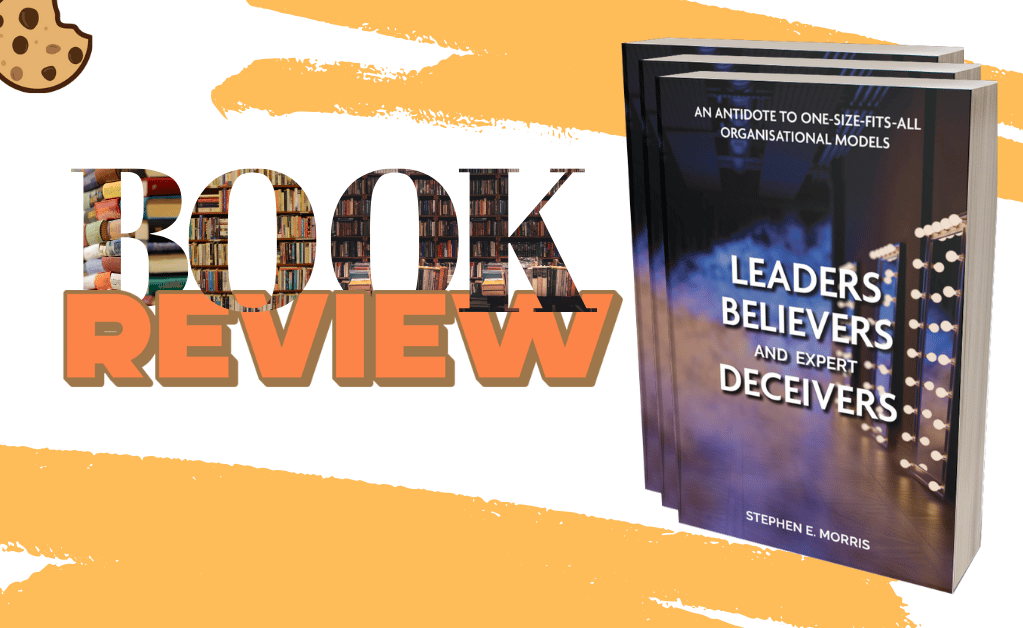Table of Contents
ToggleDo organizational frameworks really drive results, or are businesses relying too much on oversimplified solutions for complex challenges? Stephen E. Morris’ Leaders, Believers, and Expert Deceivers tackles this question head-on, delivering a refreshing, no-nonsense approach to leadership and decision-making in organizational settings.
Morris invites readers to explore what it truly means to understand their organization’s unique context. Blending wit, humor, and a touch of cynicism, this book acts as both a guide and a mirror, challenging leaders to face uncomfortable truths about their teams and systems. With its sharp insights, it inspires meaningful change and fosters effective evolution of the organization to keep it relevant to its customers, their environment, and the people within it.
Whether you’re a seasoned executive or an eager team member, Leaders, Believers, and Expert Deceivers offers valuable insights into the complexities of leadership, product delivery, and organizational dynamics.
Key Themes and Messages
1. The Importance of Sense-Making
Morris emphasizes that every organization is a complex system requiring a clear understanding of its context before determining the best course of action. Sense-making—a concept originally coined by Karl Weick—is the foundation of this process. It’s likened to a music studio’s mixing desk, where each instrument must be adjusted to achieve the perfect harmony.
Sense-making isn’t just about understanding the external environment. It means interpreting an organization’s vision, purpose, and strategy while accounting for unpredictable elements like culture, habits, and human behavior. Using sense-making frameworks like Cynefin, leaders can foster meaningful discussions and determine their next course of action that align with their goals.
2. No One-Size-Fits-All Framework
Morris challenges the idea of universal leadership solutions. Instead, he highlights that a blend of approaches is often necessary. Organizations are a dynamic mix of predictable and unpredictable situations, requiring leaders to adapt their strategies for different contexts.
Why, then, do so many organizations adopt standardized frameworks? Morris identifies several reasons, from blindly following what the boss says to seeking quick fixes for complex problems. He offers a brutally honest critique of these tendencies, encouraging leaders to move beyond the comfort of one perfect framework. It involves leveraging existing frameworks complemented with the knowledge within the organization and its partners to establish tailored solutions.
3. The Role of Direction and Strategy
Knowing an organization’s purpose and aligning it with strategy can make all the difference. Morris outlines how clarity around vision, purpose, and objectives can empower teams, enhance decision-making, and foster a sense of belonging. He advocates for breaking down grand visions into manageable components and employing a variety of styles to make them more relatable and easy to understand, using tools like Objectives and Key Results (OKRs) and team-level discussions to keep teams aligned.
An example that Morris provides is IKEA’s effective use of their showrooms to visualize the application of their products in various spaces. On a similar note, organizations should not expect that a presentation of the corporate goals and strategy through mass email or a town hall meeting will result in alignment or a common understanding of the message. They have to make it relatable and relevant.
4. Complexity in Teams and Decision-Making
Morris explores how teams differ in function and structure, emphasizing the importance of applying the right type of team for a given task. He dives deep into the development of high-performing teams, stressing the role of skills, knowledge-sharing, and real-world experience over theoretical know-how.
A common misconception about organizational capabilities- skills and knowledge that employees have – falls under a bell curve. In reality, it takes on the Paretian principle (or the 80/20 rule), where the productivity of the organization is due mostly to the skills and knowledge of 20% of the employees, thus, the chart looks more like a hockey stick instead of a bell curve: the expertise lies on the far left of the chart and takes a deep dive into the right side of the chart. Morris promotes the importance of leveraging the 20% to support and enhance the skills and knowledge of the organization.
Additionally, he highlights the challenges of culture and habits, noting that successful change requires addressing behaviours rooted in comfort zones or reservations (or fear).
5. Understanding Change and Transformation
The book concludes with actionable advice on navigating change within organizations. Change, Morris argues, is inherently challenging because it disrupts established norms and triggers both physical and social fears. To succeed, leaders must carefully consider three specific thoughts:
- Assume that both your change purpose and strategy will evolve – Embrace experimentation with different approaches, understanding that some will succeed while others may fail. It’s unrealistic to expect purpose and strategy to remain static, and trying to do so can lead to frustration for everyone involved.
- Prioritize narrative difference – Share and leverage successes from various approaches, training sessions, tools, or techniques that foster collaboration and drive improvement across the organization. These stories can inspire growth and unity.
- Iterate habits and heuristics – While these heuristics – mental shortcuts – can simplify and accelerate decision-making, it’s important to recognize when they become outdated. Actively work to adapt and transform these patterns into meaningful behavioral change.
Organizational Dynamics and Decision-Making
What sets this book apart is its nuanced exploration of organizational behavior. Morris dives deep into why organizations often stick to ineffective practices, offering thought-provoking explanations such as:
- Blindly following industry trends or popular certifications.
- Ignoring deeper problems because of cultural or habitual blind spots.
- Avoiding accountability by relying on oversimplified tools or frameworks.
He doesn’t just stop at identifying these issues—he provides solutions and examples grounded in context, critical thinking, and communication. Exercises like mapping out future scenarios or running sense-making discussions provide tangible tools for overcoming real-world challenges. Morris encourages leaders to step away from the illusion of “one perfect answer” and instead champion open dialogue, diverse perspectives, and adaptive thinking.
Final Thoughts
Stephen E. Morris’ Leaders, Believers, and Expert Deceivers is both an eye-opener and a practical guide for anyone navigating the complexities of leadership and organizational decision-making. It challenges conventional wisdom, advocates for thoughtful exploration of context, and equips readers with tools to make informed, impactful decisions.
If you’re ready to think differently about leadership, challenge the status quo, and lead your teams with intention and clarity, this book is a must-read.
Call to Action
Take the first step toward transforming your organization—grab a copy of Leaders, Believers, and Expert Deceivers. Then, get ready to inspire meaningful change where it matters most.
About the Author

Rochelle Tan
As an Agile Evangelist, Rochelle Tan has over 20+ years of experience in agile transformation with small to large organizations from various industries in North America and Asia: Oil and Gas, IT, Healthcare, Finance, Insurance, and Government.
